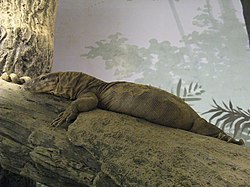| Yellow (golden) monitor lizard | |
|---|---|
 | |
| Scientific classification | |
| Kingdom: | Animalia |
| Phylum: | Chordata |
| Class: | Reptilia |
| Order: | Squamata |
| Suborder: | Anguimorpha |
| Family: | Varanidae |
| Genus: | Varanus |
| Subgenus: | Empagusia |
| Species: | V. flavescens |
| Binomial name | |
| Varanus flavescens (Hardwicke & Gray, 1827) | |
The yellow monitor (Varanus flavescens) or golden monitor is a monitor lizard native to South Asia. [1]


